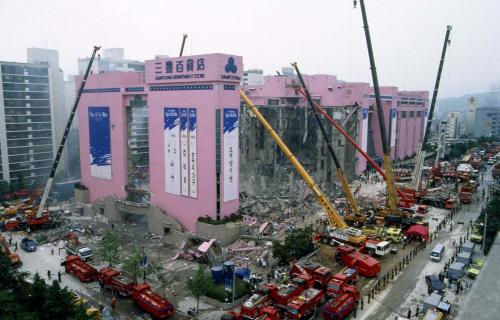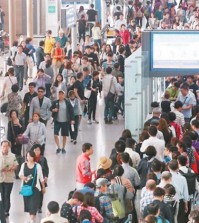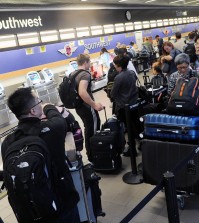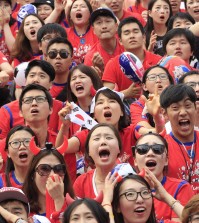- California Assembly OKs highest minimum wage in nation
- S. Korea unveils first graphic cigarette warnings
- US joins with South Korea, Japan in bid to deter North Korea
- LPGA golfer Chun In-gee finally back in action
- S. Korea won’t be top seed in final World Cup qualification round
- US men’s soccer misses 2nd straight Olympics
- US back on track in qualifying with 4-0 win over Guatemala
- High-intensity workout injuries spawn cottage industry
- CDC expands range of Zika mosquitoes into parts of Northeast
- Who knew? ‘The Walking Dead’ is helping families connect
[Guardian] Learning from Seoul’s Sampoong Department Store disaster – a history of cities in 50 buildings
Rescue workers, using cranes, continue a rescue operation Friday, June 30, 1995 following the collapse of Seoul’s Sampoong Department Store. The death toll stood at 113 in the disaster which officials blamed on shoddy construction. (AP Photo/Yun Jai-hyoung)
Observers tend to describe the rise of South Korea as a miracle, and the actual story makes the word seem only a minor exaggeration. Having emerged an utter wreck from the Korean War in the early 1950s, by the 21st century the country had become a rich, infrastructurally impressive, technologically forward-thinking global economic and cultural force. But South Korea’s unprecedentedly rapid entry into the first world has taken its tolls, and no one event of its dizzying 20th-century period of growth forced as many of its people to face them as the collapse of the Sampoong Department Store.
Those who endured the hardships of the Korean War and its aftermath had to welcome whatever prosperity the future could bring, despite the repression of the dictators who oversaw it and the grinding nature of a national life rigorously dedicated to nation-building. But from the 1970s through to the early 1990s, even the most development-minded Korean couldn’t help but suspect that something had gone wrong. An apartment block falls to the ground, a hotel catches fire, a train station explodes, a bridge collapses: the built environment that had risen so recently and triumphantly around them had already begun to crumble.
From the beginning, South Korea has understood that development and urbanisation go hand in hand. In fact, it understands that almost too well, resulting in what ranks today as one of the most capital-centric countries in the world. The resources it has devoted to Seoul make the rest of South Korea seem almost like a mere support system for that 24-hour high-rise megalopolis of 25 million people, built over the rubble of the modest Japanese colonial city it had been before the second world war.
















